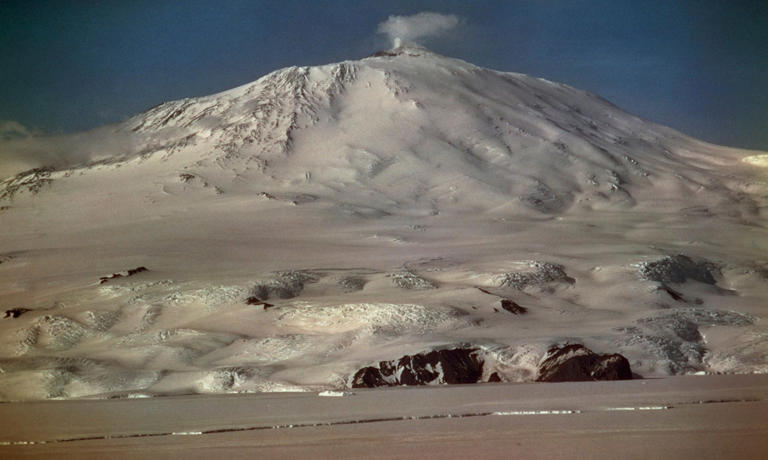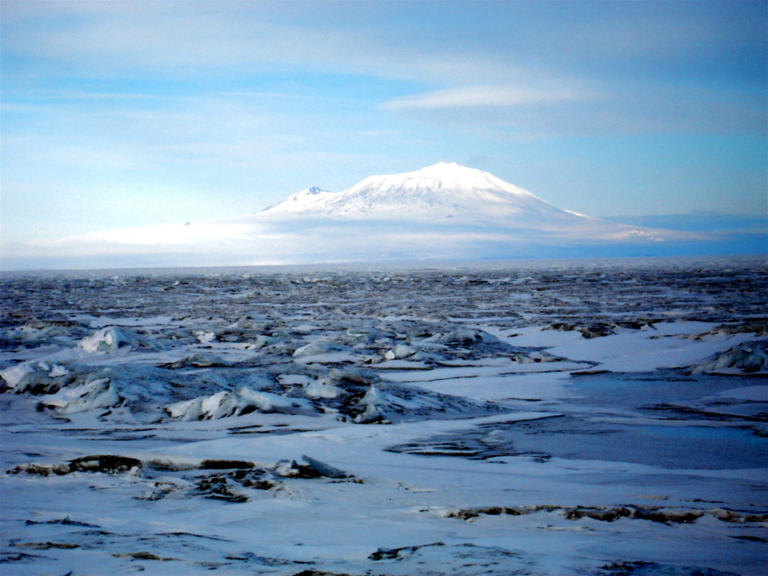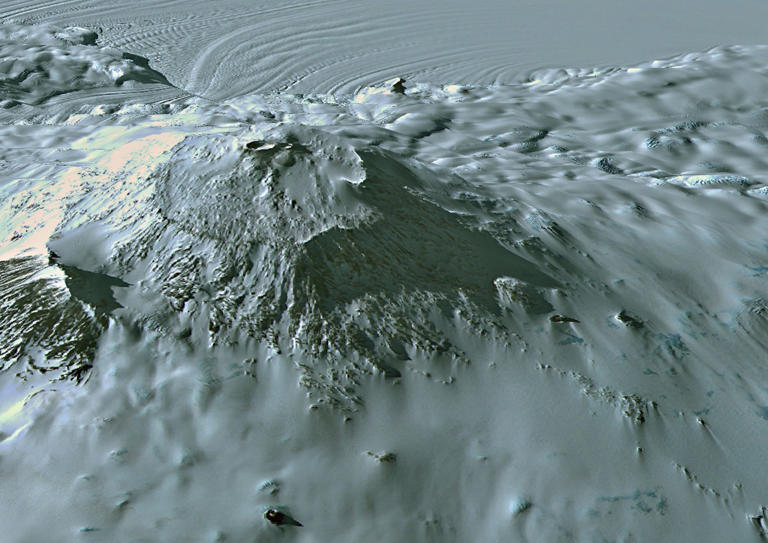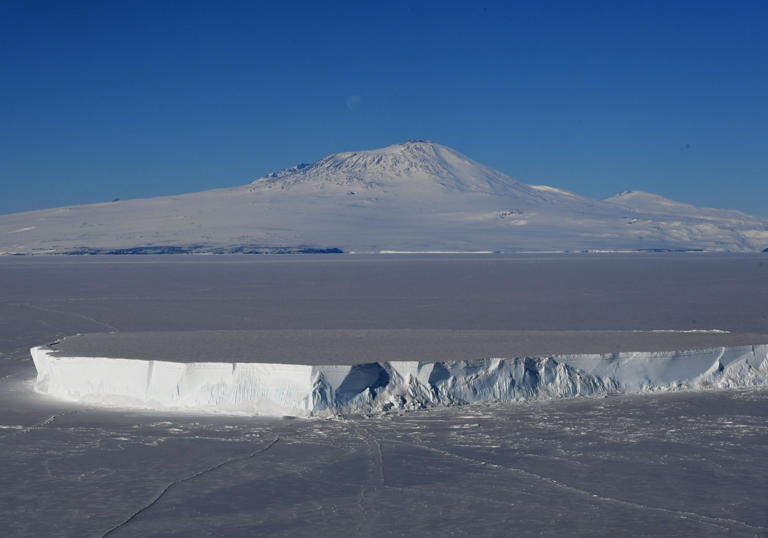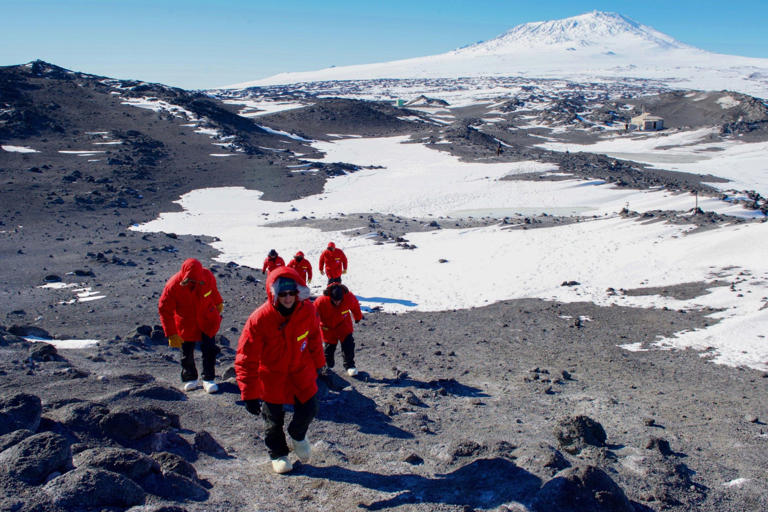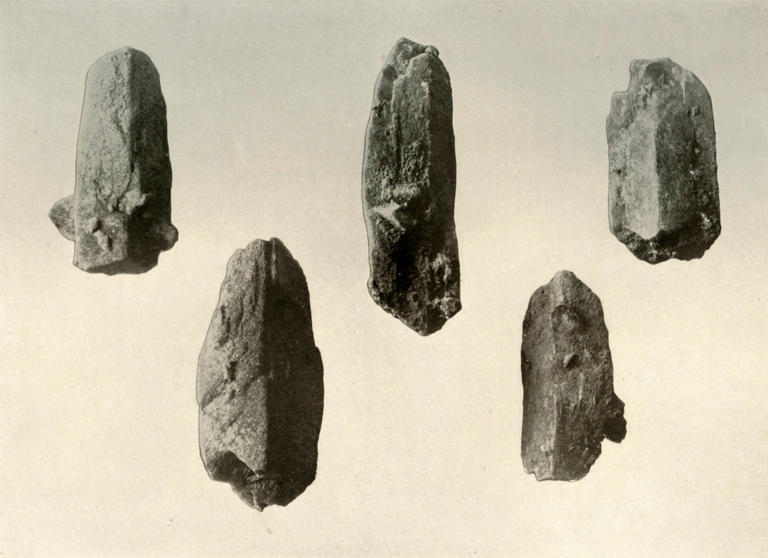WHY IS A VOLCANO IN ANTARCTICA SPEWING OUT GOLD DUST?










Why is a volcano in Antarctica spewing out gold dust?
An expert has revealed why a volcano in Antarctica is spewing out gold dust – and whether it could lead to riches.
Antarctica is a continent of contradictions, with hostile cold temperatures and sizzling lava lakes inside massive volcanos.
Mount Erebus is the world’s southern-most active volcano – and it is called one of the most ferocious on the continent, according to IFL Science.
But a gold dust volcano makes an eruption sound less scary.
Rising from the snow and ice up to 12,448ft on the Ross Island near the McMurdo Staion, it is one of eight or nine active volcanoes on the continent which has more than 130 in total. Antarctic surveyor James Clark Ross named it in 1841 after one of his ships, HMS Erebus, the name of the ancient Greek god of the underworld.
The volcano contains one of only five long-lasting lava lakes on Earth, with plumes of gas and steam rising from its depths.
Mount Erebus is also spewing out gold dust, scientists discovered in the early 1990s.
They spotted gold particles of up to 60 micrometers in the snow near the volcano.
It releases around 80 grams of gold per day which is worth around £5,000.
But British volcanologist Tamsin Mather told Metro.co.uk that gold is not the only valuable material that comes out.
Why is it happening?
Mather, professor of earth sciences at the University of Oxford, said Mount Erebus has an ‘unusual chemistry to its magma.’
‘It is pumping gas 24/7,’ she said.
‘It is one of the few that has persistent active lava lakes in its crater pulsing around, and that makes it an incredible location,’ she explained.
Occasionally, smoldering hot lava bombs also burst out of the lava lakes.
Prof Mather explained: ‘Within the gasses are particles and metals, including gold.’
They are tiny specs, just chemical compounds of gold rather than nuggets found by prospectors in the Klondike gold rush.
Despite its unusual magma, Erebus is ‘just one of many pumping out gold’, the expert said, adding that each volcano ‘has slightly different chemistry.’
Other precious metals like copper also comes out in the process.
However, harnessing the ‘metallic bounty’ is not not easy, Prof Mather said.
She continued: ‘The problem is if it is being pumped out it is really dilute.
‘It is really hard to harness it – you can not put an umbrella over a large volcano, trust me.
‘It is really hard to harness that gas coming out.’
But one way is to ‘see if we can harness the metals in volcanic brines.’
‘That might be the way to get useful metals for batteries so we can get to the Net Zero target.
She said she thought Mount Erebus making headlines again could be driven by ‘growing awareness of our need for critical metals to drive green tech.’
The expert had just returned from Mount Etna in Italy and the Caribbean where she was studying ways to harness the metals.
The extremely remote volcano is most famous for the air disaster in November 1979 when an Air New Zealand Flight 901 smashed into it.
All 237 passengers and 20 crew on board were killed after the plane flew into it on November 28 during a sightseeing flight over the continent.
Most of the wreckage remains on the remote accident site.
Articles - Latest
- FRENCH PALME D’OR WINNER LAURENT CANTET DIES AGED 63
- Norman Lear obituary
- AN UNHOLY TRAFFIC: HOW THE SLAVE TRADE CONTINUED THROUGH THE US CIVIL WAR
- QUEEN CHARLOTTE WAS ‘PERSON OF COLOUR’, MUSEUM CLAIMS IN LGBT GUIDE
- JEANETTE WINTERSON: I DIDN’T BELIEVE IN GHOSTS… UNTIL I STARTED LIVING WITH THEM
- ANCIENT HUMAN ACTIVITY DISCOVERED IN KILOMETER-LONG LAVA CAVE
- DNA ANALYSIS SPANNING 9 GENERATIONS OF PEOPLE REVEALS MARRIAGE PRACTICES OF MYSTERIOUS WARRIOR CULTURE
- LOST CITIES HIDDEN FOR THOUSANDS OF YEARS DISCOVERED UNDER FOREST
- LETTER: ALAN ARKIN OBITUARY
- ARCHAEOLOGISTS CRACK MYSTERY OF ANCIENT MAYA AFTER 7,000-YEAR-OLD REMAINS FOUND
- NEW JERSEY REP. DONALD PAYNE JR. DEAD AT 65
- WORLD'S TALLEST WOMAN' MARIA FELICIANA DOS SANTOS, 7FT3, DIES AGED 77
- UNDERWORLD DISCOVERY CHALLENGES OUR UNDERSTANDING OF HUMAN EVOLUTION
- MUSLIM SOLDIER MEMORIAL FUND £1 MILLION TO IMPROVE RELATIONS AFTER ISLAMOPHOBIA ISSUES
- SCIENTISTS DISCOVER 1ST-OF-ITS-KIND CELL PART BORN FROM A SWALLOWED MICROBE
- NYC TIKTOK STAR EVA EVANS DIES AGED 29
- LADY GARDNER OF PARKES, CONSERVATIVE PEER WHO CHAMPIONED WOMEN’S RIGHTS IN THE EU AND UN – OBITUARY
- WEBB TELESCOPE DETECTS LIGHT FROM AN EARTH-LIKE PLANET
- FORMER LABOUR MINISTER AND CROSSBENCH PEER FRANK FIELD DIES AGED 81
- LOURDES PORTILLO DEAD AT 80:OSCAR-NOMINATED FILM DIRECTOR HAS PASSED AWAY
- VAMPIRE' NEUTRON STAR BLASTS ARE RELATED TO JETS TRAVELING AT NEAR-LIGHT SPEEDS
- THE MOON IS 40 MILLION YEARS OLDER — EXPLAINED
- BARBARA O.JONES DEAD AT 82: ACTRESS WHO STARRED ALONGSIDE MUHAMMAD ALI IN TV SERIES, HAS PASSED AWAY
Articles - Most Read
- Main
- Contact Us
- The science behind Ouija boards
- Cosmic Consciousness - What is Cosmic Consciousness-2
- Cosmic Consciousness-Introduction
- Cosmic Consciousness - Introduction-2
- MASSIVE 6.1 MAGNITUDE EARTHQUAKE HITS NEW ZEALAND AS NATION STILL REELING FROM CYCLONE
- ARCHAEOLOGISTS UNRAVEL THE TRUTH OF APHRODITE, GODDESS OF LOVE, ON VALENTINE'S DAY
- The Human Condition-Thomas Keating
- Cosmic Consciousness First Words - 1V - 2
- Cosmic Consciousness First Words - V -
- Cosmic Consciousness V - 2
- Cosmic consciousness - First Words - IV
- Cosmic Consciousness - What is Cosmic Consciousness?
- Evolution and Devolution-Chapter 2
- The Human Condition - Thomas keating-3
- The Human Condition-2-Thomas Keating
- Drinking From The Mountain Stream - Milarepa
- Cosmic Consciousness-On the Plane of Self Consciousness
- The Human Condition - 4
- Cosmic Consciousness - 3 - On the Plane of Self Consciousness
- Evolution and Devolution-Chapter 1
- The Human Condition - 6
- Shakyamuni Buddha or India the 1st “Black Revolutionary Hero.”
- On the Plane of Self Consciousness - 2
- Milarepa's World
- The Human Condition - 5
- Milarepa's World-2
- The Buddhist System of Liberation
- Contemplation and the Divine Therapy - 2
- On the Plane of Self Consciousness IV
- The Buddhist System of Liberation - 2
- JERRY RAWLINGS, GHANAIAN STRONG MAN WHO CAME TO POWER IN A COUP BUT INTRODUCED DEMOCRACY – OBITUARY
- On the Plane of Self Consciousness IV - 2

